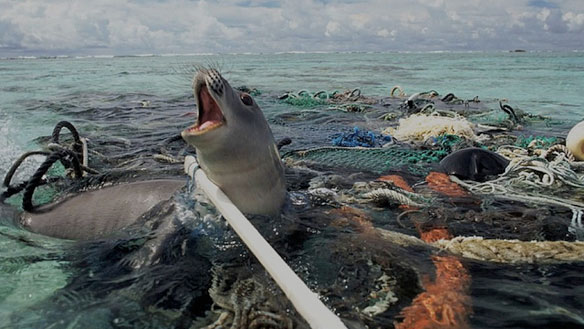
Photograph: © SAF — Coastal Care.
“Whether plastics present a unanimously accepted and proven toxic challenge to marine life, and subsequently to humans, is one of the biggest challenges facing scientists right now.
All sea creatures, from the largest to the microscopic organisms are, at one point or another, swallowing the seawater soup instilled with toxic chemicals from plastic decomposition. Much of ocean’s life is in the microscopic size range and zooplankton is the base of the food chain. As environmentalists remind the world’s population: “…We are eating fish that have eaten other fish, which have eaten toxin-saturated plastics…”
—Claire Le Guern, author: “When The Mermaids Cry: The Great Plastic Tide,” Coastal Care ©-2009.
Excerpts;
A scientist has filmed the moment plastic microfibre is ingested by plankton, illustrating how the material is affecting life beneath the waves.
The footage shows one way that plastic waste could be entering the marine and global food chain…
Read Full Article And Watch Video, BBC News (03-11-2017)
Fish for dinner? Your seafood might come with a side of plastic; Guardian UK (08-31-2016)
The Ocean Is Contaminated by Trillions More Pieces of Plastic Than Thought, IOP Science (12-08-2015)
This new study suggests there are 15 to 51 trillion micro plastic particles (those less than 200 millimeters in size) in the world’s oceans, weighing between 93 and 236,000 metric tons. This is about seven times more than scientists had previously estimated…
UN Declares War on Ocean Plastic, UNEP (02-23-2017)
More plastic than fish in the sea by 2050, Guardian UK (01-19-2016)
One refuse truck’s-worth of plastic is dumped into the sea every minute, and the situation is getting worse, according to a new report launched at the World Economic Forum today. New plastics will consume 20% of all oil production within 35 years, up from an estimated 5% today…
Microplastics Worse For Crabs And Other Marine Life Than Previously Thought; Science Daily (07-18-2014)
The tiny plastic particles polluting our seas are not only orally ingested by marine creatures, but also enter their systems through their gills, according to a new study…
Plastic Contaminates Ocean Sourced Table Salt, Scientific American (10-30-2015)
People may be breathing in microplastics, health expert warns; Guardian UK (05-10-2016)
People could be breathing in microparticles of plastic, according to a leading environmental health expert, with as yet unknown consequences on health…
Biodegradable Plastics Are Not the Answer to Reducing Marine Litter, UN News Center (11-23-2015)
Widespread adoption of products labelled ‘biodegradable’ will not significantly decrease the volume of plastic entering the ocean or the physical and chemical risks that plastics pose to marine environment, concluded a UN report released today…
New UN report finds marine debris harming more than 800 species, costing countries millions; United Nations (12-05-2016)
Marine debris is negatively affecting more than 800 animal species and causing serious losses to many countries’ economies, according to a United Nations report launched December 5th, 2016…
Plastic Pollution / When The Mermaids Cry: The Great Plastic Tide, Coastal Care ©-2009.
For more than 50 years, global production and consumption of plastics have continued to rise. An estimated 300 million tons of plastics were produced in 2015, confirming and upward trend over the past years, according to a new report by the World Economics Forum, released at Davos in January 2016.
Plastic is versatile, lightweight, flexible, moisture resistant, strong, and relatively inexpensive. Those are the attractive qualities that lead us, around the world, to such a voracious appetite and over-consumption of plastic goods. However, durable and very slow to degrade, plastic materials that are used in the production of so many products all, ultimately, become waste with staying power. Our tremendous attraction to plastic, coupled with an undeniable behavioral propensity of increasingly over-consuming, discarding, littering and thus polluting, has become a combination of lethal nature… — © SAF — Coastal Care
Collecting plastic waste near coasts ‘is most effective clean-up method’, Guardian UK (01-19-2016)
To clean up ocean plastics, increase focus on coasts, Science Daily (01-19-2016)
The most efficient way to clean up ocean plastics and avoid harming ecosystems is to place plastic collectors near coasts, according to a new study…
Loving the Ocean Starts at Home, National Geographic (09-08-2016)

“When plastic ingestion occurs, it blocks the digestive tract, gets lodged in animals windpipes cutting airflow causing suffocation, or fills the stomach, resulting in malnutrition, starvation and potentially death. Indeed, it is found that debris often accumulates in the animals’ gut and give a false sense of fullness, causing the animal to stop eating and slowly starve to death.” —Captions: © SAF — Coastal Care
Photo source: ©© Tedsgp2









